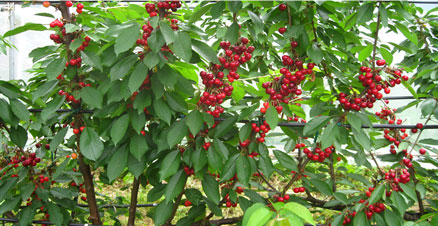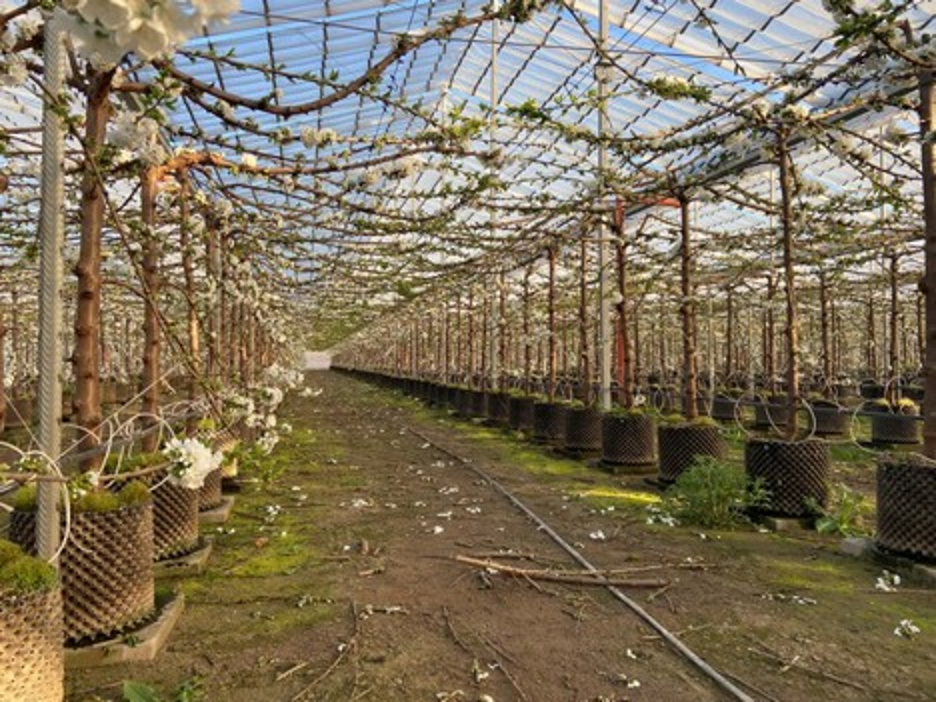Cultivation systems for cherries

You as a cherry grower are always looking for the best for you and your farm. How can you grow as efficiently as possible? And what suits you best? There are many developments in cherry growing. Many new varieties and new methods of growing. Read this article and know which methods are common, which methods are new. We know we cannot be complete with this article. We will continue to update and add to this article. This will create an increasingly complete overview of the different growing methods for cherries. Do you have any additions? Please let us know. That way we help each other grow the best cherries!
Cherries were traditionally grown with standard trees. Big tall trees of up to more than 10 metres high. Because picking was a big challenge, this has changed. Everyone still remembers the images: long ladders with baskets full of cherries. Wonderful to see!
A new tree shape was developed to make picking easier. The low-trunk trees were born. Picking went a lot easier. To protect the cherries, bird nets were made over the trees. Thus, the cherry harvest was protected.
Cherry growing continued to develop. New varieties are introduced and yields maximised. A contemporary orchard should be able to produce 18 to 20 tonnes per ha. Be able to achieve. Fruit size is an increasingly important component for a good price. Cultivation methods play an important role in fruit size.
What growing methods exist for cherries?
1. spindly trees
2. espaliers
3. V hedge
4. Lehner Method (diagonal trees)
5. Ufo method
6. Double table system
7. Pergola system
Spindle-shaped trees
Spindly trees is the cultivation method most commonly seen in orchards. Trees with one central trunk. Branches start at 70-80 cm and are up to 3.5-4 metres tall.
Tree support:
- Each tree a pole
- Or 2-3 wires with a pole per tree
- Yoke system for bending out the lower branches is an option.
To inhibit trees, root pruning is often applied. In practice, there are many differences in the pruning of these trees. However, the best cherries are grown on 2-year-old wood.
Harvest protection
This growing method can be well protected with the existing canopies available in the market. Good ventilation is important to prevent fruit rot. The fruit cover can be used to support the trees.

Slate trees
Slate trees have been a method of cultivation used for centuries. It is an intensive way of guiding the trees. There is a central trunk. Branches are guided horizontally on a support system. Cultivation is done with 5-6 horizontal branches spaced 15-20 cm apart.
Supporting the trees
- Wooden or concrete posts with 5 to 6 wires according to the number of branches to be guided
The method gives a narrow fruit wall and the row spacing is therefore often narrower than in other crops. 3.25 to 3.5 metres is common.
Harvest protection
This growing method can be well protected with the existing protection systems available in the market. The fruit cover can be used to support the trees. However, when constructing the orchard, pay attention to whether your desired system can be built at your row spacing.
V-trees
Growing cherries in V-shaped trees is a method that requires expertise. The trees are planted intensively. Sometimes at intervals of 50 cm. The trees are then led alternately to the V- hedge. A major advantage of growing cherries in V-h hedge is that picking is easy. The cherries hang outwards, so to speak. Tree growth is inhibited by root pruning. Cherries grow on 2nd-year twigs.
Tree support
- A central post in the middle. Usually made of concrete
- Multiple layers with yoke irons going from narrow to wider at the top.
- The bottom cross iron is 50 cm, then 65, then 80 then 1.00 and sometimes another one of 1.20
Harvest protection
All common fruit canopies can be applied to V hedge cultivation with cherries. Before starting with V hedges, it is important to take good stock of the row spacing. Will my boom lift fit between the systems and can I easily reach the canopy.
Lehner method/ obliquely planted trees
The trees are planted diagonally in 45-degree positions. The idea of this method is that growth is less pronounced in the head of the tree. The branches in the trunk of the tree are bent out in a table, or yoke system.
Supporting trees
- Poles with 2-3 wires.
- Trees are guided on poles diagonally.
- A yoke system at least 1 metre wide is required for the cultivation table.
Harvest protection
This growing method can be well protected with the existing canopies available in the market. The fruit cover can be used to support the trees

UFO cultivation method
Ufo method stands for Upright Fruiting Offshoot system. An originally medieval growing system that has recently been revived by a US university. The trees are planted and guided on a wire completely horizontally. The tree makes ascending shoots. On these ascending shoots, the tree produces beautiful and large cherries. After harvesting, the branch is replaced by a newly grown ascending branch. Each tree has 6-7 ascending branches spaced every 15-20 cm. The final tree height will be 3.5 to 4 metres.
Supporting trees
- Concrete or wooden posts
- Five wires are needed to guide the trees.
- No sticks are used in guiding the tree
Harvest protection
This growing method can be well protected with the existing covers available in the market. The fruit canopy can be used to support the trees

Dual table system
The double table system is a cultivation method originating from the spindle-shaped tree. First development was a table at the bottom of the tree where the straight ascending branches could be bent out. The later development is to bend out and break the top branches of the tree that often develop strongly. In the middle of the tree is a window where there are no branches.
Cherries grow on 2-year-old branches. The first year the branches grow. These are broken out in winter or spring and bent horizontally. In the following year, the branch produces its cherries.
Supporting trees
- Wooden or concrete poles
- Canes to guide the tree vertically.
- 2 yokes one at a minimum height of 75 cm and the 2nd at a height of 2 metres.
Harvest protection
This growing method can be well protected with the existing covers available in the market. The fruit cover can be used to support the trees
Pergola system
Pergola system is the latest of the methods. It involves guiding the trees over a pergola. It is very reminiscent of kiwi cultivation. The branches can be guided completely horizontally or slightly diagonally. With the slightly diagonal, the shorter picker can pick closer to the trunk and the taller one more in the middle. A slightly higher row height in the middle can also have its advantages.
The intention is for the cherries to hang at head height. So the pergola will be between 1.6 and 2.0 metres high. The cherries grow on 2-year-old branches. The branches that have borne cherries will be pruned away and replaced with new branches. This ensures constant renewal in the tree.
Supporting trees
- Poles with wires and stick to guide the vertical trunk
- Sleepers for the horizontal wire bed
Harvest protection
With the pergola system, it is a challenge because the crop grows above the driveway. So the systems have to be automatic. One option is to keep an opening between pergola for the AWP. But work will have to be done above the crop. This also gives its challenges in maintenance. Good solutions are being worked on.

As a grower, you want to choose the best for your farm! That is why we have listed these cultivation methods. If you have any additions? Send them to gerben@fruitsecurityholland.com so we can expand the article and make it even more accessible to growers who, like you, want to get ahead.
Sources:
|
Gerben van Veldhuizen Fruitprotection specialist My mission is to help as many fruit growers as possible get a good harvest. |



